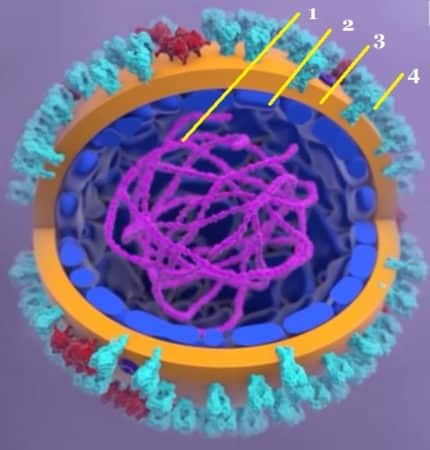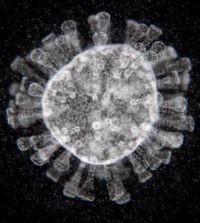What Is SARS-CoV-2, CoronaVirus or COVID-19 ?
Coronavirus disease which is also known popularly as “COVID-19” is an infectious disease caused by a newly discovered coronavirus.
SARS is an acronym for Severe Acute Respiratory Syndrome While COV is CoronaVirus and Covid-19 gotten from CoronaVirus 2019. The SARS-COV-2 belongs to the family of Corona viruses named for the Crown like spikes on their surfaces.
Most people infected with the COVID-19 virus will experience mild to moderate respiratory illness and recover without requiring special treatment. Older people or those with underlying medical problems like cardiovascular disease, diabetes, chronic respiratory disease and cancer are more likely to develop serious illness.
SARS CoV-2 or Covid 19 is a contagious viral infection that attacks primarily your throat and lungs.
Important Questions Asked About The Virus:
- What’s Inside the Virus
- What happens in your body when you contact the coronavirus?
- What exactly causes your body to develop pneumonia?
- How would a vaccine work?
♦ What are the component of COVID-19
⇒Inside The Virus:

The corona virus must infect living cells in order to reproduce.
Lets have a closer look inside the virus; From the numbering of the image above below are the content.
- genetic material contains the information to make more copies of itself.
- A protein shell provide a hard protective enclosure for the genetic material as the virus travels between the people it infects.
- An outer envelope allows the virus to infect cells by merging with the cell’s outer membrane.
- Projecting from the envelope are spikes of protein molecules.
Both a typical influenza virus and the new corona virus use the spikes like a key to get inside a cell in your body, where it takes over the cell’s internal machinery repurposing it to build the components of new viruses.
♦ How Can You Contact Corona Virus
When an infected person talks, Coughs or sneezes, droplets carrying the virus may land in your mouth or nose and then move into your lungs. That is, the COVID-19 virus spreads primarily through droplets of saliva or discharge from the nose when an infected person coughs or sneezes, so it’s important that you also practice respiratory etiquette (for example, by coughing into a flexed elbow).
Its a releif that the droplets does not travle more than one metere from dipersal cause the virus molecules or droplets are heavy but not inactive as they could rest on a surface and remain dormant for a short period. Studies shows that the virus could survive outside a host for five minutes, don’t get excited cause a lot can happen in five minutes especially in crowded area.
♦ How Does Corona Virus Spread In Your Body when you contact it?
Once the virus is inside your body, the Virus comes in contact with cells in your throat, nose or lungs. One spike on the virus inserts into a receptor molecule on your healthy cell membrane like a key in a lock. This action allows the virus to get inside your cell. A typical flu virus would travel inside a sack made from your cell membrane to your cell’s nucleus that where your cell houses all its genetic material.
The Corona virus on the other hand doesn’t need to enter the Host cell nucleus, it can directly access parts of the Host Cell called Ribosomes. Ribosomes use genetic information from the virus to make viral proteins such as the spikes and virus’s surface. A packaging structure in your cell then carries the spikes in vesicles, which merge with cell’s outer layer, the cell membrane.
All the parts needed to create a new virus gather just beneath your cell’s membrane. Then a new virus begins to butt off from the cell’s membrane.
Imagine a platform where you can be paid a whooping 2,200 just for watching one video. are you looking for a place where you can grow your business, and earn income – all within a supportive and vibrant community. Look no further than Veritas Global, the revolutionary social network designed to empower personal and professional success.
♦ What Happens In Your Body When You Contact Coronavirus?
Most people infected with the COVID-19 virus will experience mild to moderate respiratory illness and recover without requiring special treatment. Older people, and those with underlying medical problems like cardiovascular disease, diabetes, chronic respiratory disease, and cancer are more likely to develop serious illness.
♦ What Exactly Causes Your Body To Develop Pneumonia?
Now, with the virus is spreading or traveling in your body, how Can You Develop Pneumonia Symptoms?
Well for you to get this properly, let’s look into your lungs.
Each Lung has Separate sections called lobes. Normally, as you breathe, air moves freely through your trachea or windpipe, then through large tubes, called bronchi, through smaller tubes called bronchioles and finally into tiny sacs called alveoli.
Your airways and alveoli are flexible and springy so when you breathe in, each air sac inflates like a small balloon and when you exhale, the sacs deflate. Small blood vessels called capillaries surround your alveoli. Oxygen from the air you breathe passes into your capillaries, then the carbon dioxide from your body passes out of your capillaries into your alveoli so that your lungs can get rid of it when you exhale.
Note: Your airways catch most germs in the mucus that lines your trachea, bronchi and Bronchioles.
♦ How Does the body remove these Mucus an germs?
In a healthy body, hair-like cilia lining the tubes constantly push the mucus and germs out of your airways, where you may expel them by coughing. Normally, cells of your immune system attack viruses and germs that make it past your mucus and cilia and enter your alveoli.
However, if your immune system is weakened like in the case of a corona virus infection, the virus can overwhelm your immune cells and your bronchioles and alveoli become inflamed as your immune system attacks the multiplying viruses.
The inflammation can cause you’re alveoli to fill with fluid making it difficult for your body to get the oxygen it needs. You could develop lobar pneumonia where one lobe of your lungs is affected or you could have bronchopneumonia that affects many areas of both lungs.
Pneumonia may cause difficulty breathing, chest pain, coughing, fever and chills, confusion, headache, muscle pain and fatigue. It can also lead to more serious complications such as respiratory failure which occurs when your breathing becomes so difficult that you need a ventilator machine to help you breathe. These are the machines that save lives and that medical device companies currently ramp up production for.
Whether you would develop these symptoms depends on a lot of factors such as your age and whether you already have an existing condition or not. Because of this the push to develop a coronavirus vaccine is moving at high speed.
♦ Recent Studies On other Corona Viruses
The Recent Studies of other coronaviruses lead most researchers to assume that people who have recovered from a SARS-CoV-2 (COVID-19) infection could be protected from re-infection for a period of time. But that assumption needs to be backed by empirical evidence and some studies suggest otherwise.
There are several different approaches for a potential vaccine against the coronavirus. The basic idea is that you would get a shot that contains faint versions of the virus.
♦ How Would A Vaccine Work?
The vaccine would expose your body to the virus that is too weak to cause infection but just strong enough to stimulate an immune response. Within a few weeks, cells in your immune system would make markers called antibodies which would be specific for only the coronavirus or specifically its spike protein.
Antibodies then attach to the virus and prevent it from attaching to your cells. Your immune system then responds to signals from the antibodies by consuming and destroying the clumps of viruses.
If you then catch the real virus at a later stage, your body would recognise it and destroy it. In other words, your immune system is now primed.
♦ Concluding
Collecting evidence on whether this will be possible, safe and effective is part of what’s taking researchers so long to develop the vaccine. It is a Race against Time to develop the vaccine amid a pandemic.
Each step in vaccine development usually takes months if not years. For instance an Ebola Virus vaccine broke records by being ready in five years. So the hope here is to develop one for the new coronavirus in a record-breaking 12 to 18 months.
While all this will take time, stay home if you can and care to protect the most vulnerable and don’t forget to wash your hands for at least 20 seconds and as often as possible.
 Skip to content
Skip to content 

